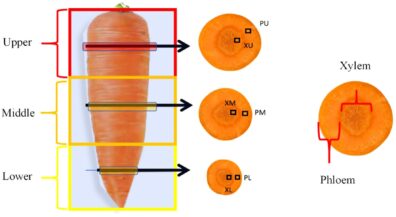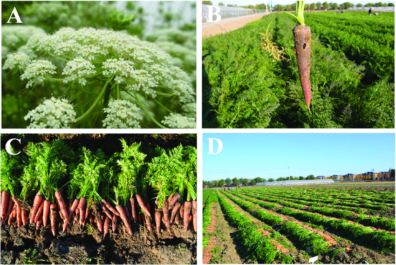Dear George and Samuel,
Roasted and soft. Raw and crunchy. Baked into a cake. I love eating all kinds of carrots.
I asked my friend Tim Waters why those orange veggies are so tasty. He studies vegetable crops at Washington State University.
He told me that we eat the carrot plant’s root. That’s where the plant stores all the sugar it makes during photosynthesis.
“The sugars that carrots have are sucrose, glucose and fructose,” Waters said. “They’re stored in the root as a source of energy for the plant while it’s growing.”
It turns out carrots are biennial plants. It takes two years for a carrot plant to go through its whole growth cycle.
The xylem and phloem tubes move stuff around inside a plant. It’s like a highway. Water and minerals travel in the xylem. Sugar and nutrients travel in the phloem. Image: Ying Zhao et al. Creative Commons
Let’s say you plant a carrot seed in the spring. It’ll sprout and grow green leaves aboveground. That’s the carrot plant’s vegetative growing stage.
Those leaves contain a green pigment called chlorophyll. Its job is to absorb the sun’s light. Then the plant uses that light energy to change water and carbon dioxide (from the air) into sugar and oxygen.
Your carrot plant sends the sugar it makes down a tube called the phloem, all the way to the root. It gets stored in plant cells there.
When winter comes, your carrot plant will enter a resting stage. It just sits there.
The next spring, the reproductive stage starts. Your plant will use its stored energy to send up a seed stalk. The seeds it makes will become the next crop of carrots.
“The evolutionary strategy for that storage root is to make sure the plant has energy the next year to make seed,” Waters said. “It’s for the next generation.”

This is what carrot flowers look like (top left). Waters also told me that baby carrots aren’t really babies. They’re long carrots chopped into convenient pieces. Image: Que Fang et al. CC BY 4.0
Growers harvest carrots during the summer and fall of the first year—before the ground freezes. That’s when the carrot root is succulent and full of sugar.
After the seed stalk goes up the second spring, the carrot roots are hollow and super hard. Waters told me that biting into a carrot then would be like chomping on a piece of wood.
But don’t let the sweetness of early carrots fool you. They’re super nutritious. They have lots of fiber. That slows down digestion, so you absorb the carrot’s sugar a little bit at a time.
And growers can plant and harvest tons of them.
“You can actually grow more nutrition per acre with carrots than you can with any other vegetable crop,” Waters said. “They’re so nutritious, and the yields are between 35 and 55 tons to the acre.”
That’s the weight of about 25 cars from an area smaller than a football field.
“When you think about feeding people high quality nutrition, carrots are one of the best ways to go because they’re so efficient,” he said.
It turns out carrots are an excellent way to get to the root of good nutrition.
Sincerely,
Dr. Universe